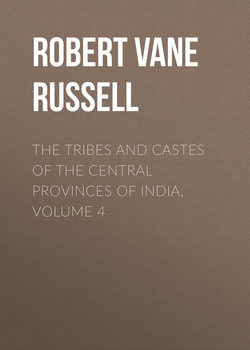Читать книгу The Tribes and Castes of the Central Provinces of India, Volume 4 - Robert Vane Russell - Страница 76
Part II
Articles on Castes and Tribes
Kumhār—Yemkala
Vol. IV
Kurmi
37. Clothes
ОглавлениеLandowners usually have a long coat known as angarkha reaching to the knees, with flaps folding over the breasts and tied with strings. The bandi is a short coat like this but coming only to the hips, and is more popular with cultivators. In the cold weather it is frequently stuffed with cotton and dyed dark green or dark blue so as not to show the dirt. For visits of ceremony a pair of paijāmas are kept, but otherwise the dhoti or loin-cloth is commonly worn. Wearing the dhoti pulled half-way up to the thighs is called ‘cultivator’s fashion.’ A shirt may be worn under the coat; but cultivators usually have only one garment, nowadays often a sleeveless coat with buttons in front. The proper head-dress is the pagri, a piece of coloured cloth perhaps 30 feet long and a foot wide, twisted tightly into folds, which is lifted on and off the head and is only rarely undone. Twisting the pagri is an art, and a man is usually hired to do it and paid four annas. The pagris have different shapes in different parts of the country, and a Hindu can tell by the shape of a man’s pagri where he comes from. But nowadays cultivators usually wear a dupatta or short piece of cloth tied, loosely round the head. The tenant arranges his head-cloth with a large projection on one side, and in it he carries his chilam or pipe-bowl, and also small quantities of vegetables, salt or condiments purchased at the bazār. In case of necessity he can transform it into a loin-cloth, or tie up a bundle of grass with it, or tie his lota to it to draw water from a well. ‘What can the washerman do in a village where the people live naked?’ is a Chhattīsgarhi proverb which aptly indicates that scantiness is the most prominent feature of the local apparel. Here a cloth round the loins, and this usually of meagre dimensions, constituted, until recently, the full dress of a cultivator. Those who have progressed a stage farther throw a cloth loosely over one shoulder, covering the chest, and assume an apology for a turban by wrapping another small rag carelessly round the head, leaving the crown generally bare, as if this part of the person required special sunning and ventilation. Hindus will not be seen out-of-doors with the head bare, though the Gonds and other tribes only begin to wear head-cloths when they are adopting Hinduism. The Gondi fashion was formerly prevalent in Chhattīsgarh. Some sanctity attaches to the turban, probably because it is the covering of the head. To knock off a man’s turban is a great insult, and if it drops off or he lets it fall, it is a very bad omen.
Group of women in Hindustāni dress
